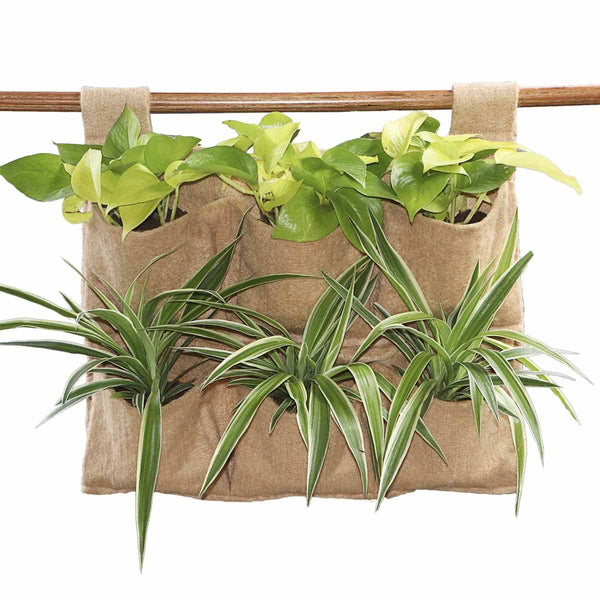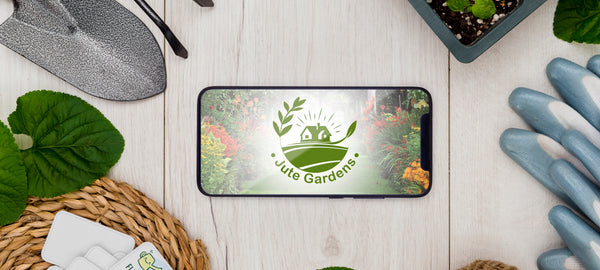
Vertical Garden Irrigation 101: Drip vs. Misting for Pocket Walls
Why irrigation matters in pocket walls
Vertical gardens don’t dry evenly. Top pockets and edges often dry first, and hand‑watering can leave some plants soggy while others stay thirsty. The result can be:
-
Rot (too wet): yellowing leaves, mushy stems.
-
Stress (too dry): crispy edges, droop at day’s end.
-
Mess & pests: pooling water can invite fungus gnats and stains.
Your goal: Keep the root zone evenly moist while directing light runoff into a catch tray—not onto floors or walls.
Two ways to water: drip vs. misting
| Method | Best for | Pros | Cons | Indoor Mess Risk |
|---|---|---|---|---|
| Drip (micro‑emitters or perforated line) | Herbs, salad greens, trailing houseplants | Precise, efficient, quiet, easy to automate | Slightly more setup; occasional emitter clogs | Low |
| Misting (fine spray nozzles) | Leaf refresh, humidity bump, leafy greens in plant rooms | Very fast coverage; boosts turgor | Overspray; spotting on glass/walls; needs higher pressure | Medium–High |
Recommendation: If your wall is indoors, choose drip first. Add mist only if you have splash guards or an enclosed area.
Choose your water source (simple & safe)
Option A: Recirculating reservoir (indoor‑friendly)
-
A food‑safe bin or bucket sits below the wall. A submersible pump sends water up the lines on a timer.
-
Pros: No plumbing, easy to move, low leak risk, great for renters.
-
Cons: You’ll top up the reservoir and clean it monthly.
Option B: Tap‑fed system (advanced)
-
Connect to a cold‑water line with a pressure reducer, filter, and proper backflow prevention.
-
Pros: Fully automatic.
-
Cons: More parts, more leak risk, usually requires a pro.
Most indoor setups are happiest with Option A.
Parts lists (with metric & imperial notes)
A) Drip kit (recirculating) for 6–18 pockets
-
Reservoir: 10–20 L (2.5–5 gal) food‑safe container with lid
-
Submersible pump: 200–400 L/h (50–100 GPH), rated for your vertical lift (head height)
-
Smart plug or digital timer (indoor‑rated)
-
Inline micro filter
-
Main line tubing: 6 mm (¼") vinyl or poly
-
Barbed tees & elbows
-
Drip line: 6 mm (¼") with 1 L/h (≈0.26 GPH) emitters or short lengths of perforated drip for each row
-
Check valve / anti‑siphon near pump outlet
-
Mounting clips + catch tray or waterproof mat under the wall
B) Misting kit (best for covered outdoor/plant room)
-
Diaphragm pump: 3–5 L/min (0.8–1.3 GPM) capable of ~40–70 PSI
-
Accumulator (optional; smooths pulsing)
-
Filter, misting nozzles (10/24 thread or push‑fit), 6 mm (¼") tubing
-
Timer that supports short bursts (10–60 s)
-
Splash control: drip edge, curtain, or side panels
Sizing tip: Measure head height (reservoir waterline to the top of your wall). Choose a pump whose max head comfortably exceeds that by ~30%.
Layouts that water evenly (and look tidy)
Drip layout (indoor standard)
-
Run a main line straight across the top of the wall; secure with small clips.
-
Tee down to each row with short drip segments (15–30 cm / 6–12").
-
Place one 1 L/h emitter per pocket (two for very thirsty plants).
-
Leave end caps accessible so you can flush the line monthly.
[Diagram idea: Reservoir → Pump → Filter → Main Line → Tees → Emitters → Catch tray]
Misting layout (advanced)
-
A single header across the top with nozzles spaced 15–30 cm (6–12") apart.
-
Add side/back shields and a catch tray to control overspray.
Timers & schedules (start here, then tune)
Baseline (indoors):
-
Drip: 2–3 minutes, 1–2×/day. Check the middle pockets for moisture; adjust by ±1 minute.
-
Misting (optional leaf refresh): 20–40 seconds, 1–3×/day only if overspray is contained.
Seasonal tuning (Canada):
-
Winter (dry air): Slightly increase frequency or runtime.
-
Humid summer: Slightly decrease frequency to avoid sogginess.
Quick guide by plant type
-
Herbs (basil, mint, parsley): Drip 2–3 min, 2×/day.
-
Salad greens (lettuce, arugula): Drip 2–3 min, 1–2×/day; optional mid‑day mist 20 s.
-
Trailing houseplants (pothos, philodendron): Drip 1–2 min, 1×/day.
-
Thirsty outliers (mint, nasturtium): Add a second emitter or +1 minute to that row.
Keep it clean: rot, algae, and stains
-
Rot control: Aim for light runoff (5–10%) into a catch tray—never pooling in pockets.
-
Algae: Keep the reservoir lidded; use opaque tubing; wipe leaves that stay wet.
-
Emitter clogs: Flush lines monthly; soak emitters in warm water with a splash of vinegar.
-
Leaks: Hand‑tighten fittings; use mini clamps on barbed connectors; test for 2–3 minutes before leaving it unattended.
First‑time setup (drip, step‑by‑step)
-
Mount your Pocket Vertical Wall Garden securely. (Internal link: product page)
-
Place the reservoir below the lowest pocket; fill with clean water.
-
Attach pump → filter → main line; prime the line.
-
Clip the main line across the top; tee short segments down to each row.
-
Install one emitter per pocket; cap the ends for easy flushing.
-
Add a check valve near the pump outlet to prevent siphoning drips.
-
Set the timer to 2 minutes, twice daily to start.
-
Run a test cycle; confirm even moisture (top, middle, bottom). Tweak runtime as needed.
Haven’t mounted your wall yet? Start with Installing a Vertical Garden. (Internal link: guide)
Troubleshooting quick chart
| Symptom | Likely Cause | Quick Fix |
|---|---|---|
| Top row dry, bottom soggy | Gravity bias; no check valve | Add check valve; shorten runtime; add extra emitter to top row |
| One pocket always dry | Kinked line or clogged emitter | Straighten tubing; replace emitter; flush line |
| Gnats near pockets | Constantly wet media | Shorter cycles; increase airflow; let top 1–2 cm dry |
| Drips after pump stops | Siphoning from high line to reservoir | Add anti‑siphon valve or loop line above top pocket |
| Water on floor | Overspray or loose fitting | Switch to drip or add splash guards; re‑seat push‑fits |
What it costs (rough, CAD)
-
Drip starter (6–12 pockets): $55–$95 for pump, tubing, emitters, timer, filter, and clips.
-
Misting starter: $120–$220 for diaphragm pump, nozzles, filter, timer, and splash control.
Costs vary by store and brand; most parts are standard and widely available.
Nice‑to‑have upgrades
-
Moisture sensor + smart plug: Water only when needed.
-
Two‑zone splitter: Separate schedules for herbs vs. tropicals.
-
Light nutrient dosing: If you feed, flush monthly to prevent salt build‑up.
Maintenance mini‑calendar
-
Weekly: Top up reservoir; wipe leaves; quick leak check.
-
Monthly: Flush lines for 5 minutes; clean filter; vinegar‑soak any sluggish emitters.
-
Quarterly: Deep clean reservoir and pump intake.
Safety & indoor etiquette
-
Plug into a GFCI outlet; keep cords with a drip loop below the plug.
-
Place a waterproof tray or mat under the wall.
-
Never run the pump dry.
Before/after gallery (optional)
[Image idea set:]
-
Hand‑watering only (uneven growth).
-
Drip installed (even, tidy).
-
Drip + short mist burst in a contained plant room (lush leaves).
Ready to build yours?
-
Shop: Build your wall with our Pocket Vertical Wall Gardens.
-
Learn: Not mounted yet? Start with Installing a Vertical Garden.

